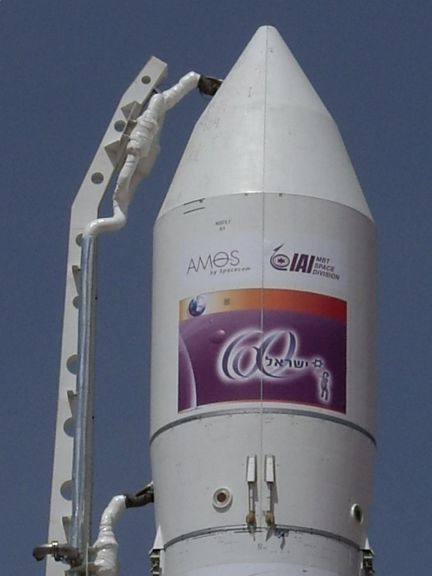In seven hours and 19 minutes, the satellite should reach the Clark Belt, which is at an altitude of 36 thousand kilometers* Amos 3 will be the first western satellite to be thrown directly into orbit

The Amos 3 satellite was launched this morning at eight (about 3 minutes ago). In about seven hours and 19 minutes he should reach the Clark Belt.
The satellite was launched from Baikonur in Kazakhstan by the three-stage Zenit launcher (called Zenit-3SLB) of the Land-Launch company. This is a terrestrial version of a Sea-Launch launcher that launches satellites from the heart of the Pacific Ocean. The Sea-launch project that began in 1995 has managed to launch 26 launches with great success in the three-stage version of the Zenit called Zenit-3SL (the pair of letters SL equals Sea-launch).
The three-stage launcher is based on a two-stage launcher called the Zenit-2 that was launched 37 times from Baikonur starting in 1985. Among other things, this launcher was originally adapted to carry the Russian Buran shuttle and flights to Mars.
The third stage, the Block-DM, was originally designed to be a very important component of the manned lunar program of the former USSR and also flew on the Proton launcher. This stage recently celebrated its 250th flight with very high reliability.
The three-stage launcher, the Zenit-3SLB, stands 59 meters tall and weighs over 460 tons at launch!
Direct injection into the track
Amos-3 will be the first western satellite to be thrown directly into geostationary orbit at an altitude of 36 thousand km, by a "Zenith" launcher and an additional third stage (BLOCK-DM). This use became possible with the development of the commercial use of Russian giant missiles.
The uniqueness is expressed in the launch of the satellite directly to the Clark Belt, something that is not customary in most launches of communications satellites that usually enter transit orbit only and only reach their final point in the Clark Belt thanks to their independent engines.
This trend is the main one in the world today in Russian satellite launches, and we expect that other western countries will follow us in adopting it.
Due to the direct injection into orbit in Amos-3, less fuel is needed - (420 kg compared to 760 kg in Amos-2), which allows for an increase in the payload, which is the satellite communication equipment, by more than 55% (250 kg compared to 160 kg per load-2)
The use of this launcher makes it possible to launch a lighter satellite than its predecessor, yet with an expected lifespan of about 18 years (six years more than the planned lifespan of Amos-2).
We will update again during the day, especially towards the final stages of the injection into the track to monitor whether they are progressing.

8 תגובות
pleasantness:
See response 4
Question to the website editor why there are no video images of the launch
Thanks to Tal and Shay. I returned.
I can only offer a free translation, feel free to correct me in wording and terms:
The "ZENIT" launcher with the "ДМ-SLБ" booster (DM-SLB) and the Israeli space station "AMOS-3" was launched today at 9:00 a.m. Moscow time from the launch station in Ikanor.
In the last day this is the second successful launch carried out according to the calculations of the federal agency ROSCKOSMOS.
After a second activation (:1510 and 53 seconds)
and a third (16:5 and 50 seconds) of the booster engines
"ДМ-SLБ" manufactured by RKK (Rocket and Space Corporation) – «Энергия» (ENERGIA) named after SP Koroliov
The space facility will move from transit orbit to the Sumy orbit at 16:08
The separation of the satellite from the accelerator will take place at 16:19 and 11 seconds.
The "Amos-3" satellite is intended for the provision of civil communication services, manufactured by Israel Aircraft Industries
Commissioned by IAI Spacecom
The launch video
http://msnvideo.msn.co.il/video/default.aspx?g=c709e9b8-826a-4227-9d29-ed4228b23f69
Received telemetry from the satellite - everything is fine
For the sake of the uneducated in the Russian language, would it be possible to translate the news?
Thanks
He thanked the media from the Russian company for dispatch services
28-04-2008 The launch vehicle "Zenit" with the booster block "DM-SLB" and the Israeli spacecraft "Amos-3" launched this morning from Baikonur. Over the past day - this is the second successful launch, made by Roskosmos calculations
The launch vehicle "Zenit" with the booster block "DM-SLB" and the Israeli spacecraft "Amos-3" launched this morning from Baikonur. In the last day - this is the second launch, produced by the calculations of the Federal Space Agency (Roscosmos).
The launch vehicle "Zenith" with the booster block "DM-SLB" successfully launched today at 9.00:3 a.m. Moscow time from the Baikonur Cosmodrome. Spacecraft «Amos-10» has been launched into a support orbit. After the second (at 15 hours 53 minutes 16 seconds) and the third (at 5 hours 50 minutes 16 seconds) turning on the engines of the booster block "DM-SLB" (this is a product of the RKK "Energy" named after S.P. Korolev) - spacecraft It will be launched from geotransitional orbit to the target (in 8 hours and XNUMX minutes).
And the separation of the spacecraft from the booster block will take place at 16 hours, 19 minutes, and 11 seconds.
The space apparatus «Amos-3» is intended for the telecommunication support of civilian consumers, manufactured by the company «Israel Aircraft Industries». Customer – company «IAI Spacecom».